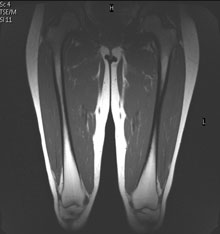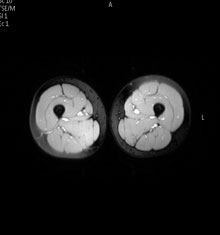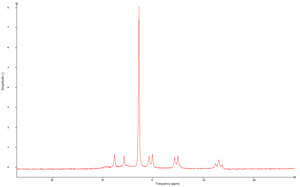
University home | Studying | Research | Business and community | Working here | Alumni and supporters | Our departments | Visiting us | About us
Exeter MR Research Centre
Human Bioenergetics Group
The Bioenergetics and human performance research group focuses on understanding and enhancing human performance through integrated physiological, psychological and biomechanical lines of enquiry. Human performance transcends all ages of life and is critical in health and disease and for supreme athletic performance. Through our interdisciplinary approach we aim to understand the factors that limit human performance and implement strategies (exercise, pharmacological, psychological, and technological) to improve performance across a range of human populations. While much of our research is conducted within a sporting context, it maintains applications in non-sporting environments where individuals perform under stressful conditions such as in business, education and medicine.




|
Collaborators

1- Nitrates
| Summary | Exercise in hypoxia is associated with reduced muscle oxidative function and impaired exercise tolerance. We hypothesised that dietary nitrate supplementation (which increases plasma [nitrite] and thus NO bioavailability) would ameliorate the adverse effects of hypoxia on muscle metabolism and oxidative function. In a double-blind, randomised crossover study, nine healthy subjects completed knee-extension exercise to the limit of tolerance (Tlim), once in normoxia (20.9% O2; CON) and twice in hypoxia (14.5% O2). During 24 h prior to the hypoxia trials, subjects consumed 0.75 L of nitrate-rich beetroot juice (9.3 mmol nitrate; H-BR) or 0.75 L of nitrate-depleted beetroot juice as a placebo (0.006 mmol nitrate; H-PL). Muscle metabolism was assessed using calibrated 31P-MRS. Plasma [nitrite] was elevated (P < 0.01) following BR (194 ± 51 nM) compared to PL (129 ± 23 nM) and CON (142 ± 37 nM). Tlim was reduced in H-PL compared to CON (393 ± 169 vs. 471 ± 200 s; P < 0.05) but was not different between CON and H-BR (477 ± 200 s). The muscle [PCr], [Pi] and pH changed at a faster rate in H-PL compared to CON and H-BR. The [PCr] recovery time constant was greater (P < 0.01) in H-PL (29 ± 5 s) compared to CON (23 ± 5 s) and H-BR (24 ± 5 s). Nitrate supplementation reduced muscle metabolic perturbation during exercise in hypoxia and restored exercise tolerance and oxidative function to values observed in normoxia. The results suggest that augmenting the nitrate–nitrite–NO pathway may have important therapeutic applications for improving muscle energetics and functional capacity in hypoxia. |
|---|---|
| References; | Vanhatalo A, Fulford J, Bailey SJ, Blackwell JR, Winyard PG, Jones AM. (2011) Dietary nitrate reduces muscle metabolic perturbation and improves exercise tolerance in hypoxia. J Physiol, 589(22):5517-28. |
| Title | Dietary nitrate supplementation reduces the O2 cost of walking and running: a placebo-controlled study. |
|---|---|
| Summary | Dietary supplementation with beetroot juice (BR) has been shown to reduce resting blood pressure and the O(2) cost of submaximal exercise and to increase tolerance to high-intensity cycling. We tested the hypothesis that the physiological effects of BR were consequent to its high NO(3)(-) content per se, and not the presence of other potentially bioactive compounds. We investigated changes in blood pressure, mitochondrial oxidative capacity (Q(max)), and physiological responses to walking and moderate- and severe-intensity running following dietary supplementation with BR and NO(3)(-)-depleted BR [placebo (PL)]. After control (nonsupplemented) tests, nine healthy, physically active male subjects were assigned in a randomized, double-blind, crossover design to receive BR (0.5 l/day, containing ~6.2 mmol of NO(3)(-)) and PL (0.5 l/day, containing ~0.003 mmol of NO(3)(-)) for 6 days. Subjects completed treadmill exercise tests on days 4 and 5 and knee-extension exercise tests for estimation of Q(max) (using (31)P-magnetic resonance spectroscopy) on day 6 of the supplementation periods. Relative to PL, BR elevated plasma NO(2)(-) concentration (183 ± 119 vs. 373 ± 211 nM, P < 0.05) and reduced systolic blood pressure (129 ± 9 vs. 124 ± 10 mmHg, P < 0.01). Q(max) was not different between PL and BR (0.93 ± 0.05 and 1.05 ± 0.22 mM/s, respectively). The O(2) cost of walking (0.87 ± 0.12 and 0.70 ± 0.10 l/min in PL and BR, respectively, P < 0.01), moderate-intensity running (2.26 ± 0.27 and 2.10 ± 0.28 l/min in PL and BR, respectively, P < 0.01), and severe-intensity running (end-exercise O(2) uptake = 3.77 ± 0.57 and 3.50 ± 0.62 l/min in PL and BL, respectively, P < 0.01) was reduced by BR, and time to exhaustion during severe-intensity running was increased by 15% (7.6 ± 1.5 and 8.7 ± 1.8 min in PL and BR, respectively, P < 0.01). In contrast, relative to control, PL supplementation did not alter plasma NO(2)(-) concentration, blood pressure, or the physiological responses to exercise. These results indicate that the positive effects of 6 days of BR supplementation on the physiological responses to exercise can be ascribed to the high NO(3)(-) content per se. |
| References; | Lansley KE, Winyard PG, Fulford J, Vanhatalo A, Bailey SJ, Blackwell JR, Dimenna FJ, Gilchrist M, Benjamin N, Jones AM. (2011). Dietary nitrate supplementation reduces the O2 cost of walking and running: a placebo-controlled study. J Appl Physiol. 110(3): 591-600. |
| Title | Dietary nitrate supplementation enhances muscle contractile efficiency during knee-extensor exercise in humans. |
|---|---|
| Summary | The purpose of this study was to elucidate the mechanistic bases for the reported reduction in the O(2) cost of exercise following short-term dietary nitrate (NO(3)(-)) supplementation. In a randomized, double-blind, crossover study, seven men (aged 19-38 yr) consumed 500 ml/day of either nitrate-rich beet root juice (BR, 5.1 mmol of NO(3)(-)/day) or placebo (PL, with negligible nitrate content) for 6 consecutive days, and completed a series of low-intensity and high-intensity "step" exercise tests on the last 3 days for the determination of the muscle metabolic (using (31)P-MRS) and pulmonary oxygen uptake (Vo(2)) responses to exercise. On days 4-6, BR resulted in a significant increase in plasma [nitrite] (mean +/- SE, PL 231 +/- 76 vs. BR 547 +/- 55 nM; P < 0.05). During low-intensity exercise, BR attenuated the reduction in muscle phosphocreatine concentration ([PCr]; PL 8.1 +/- 1.2 vs. BR 5.2 +/- 0.8 mM; P < 0.05) and the increase in Vo(2) (PL 484 +/- 41 vs. BR 362 +/- 30 ml/min; P < 0.05). During high-intensity exercise, BR reduced the amplitudes of the [PCr] (PL 3.9 +/- 1.1 vs. BR 1.6 +/- 0.7 mM; P < 0.05) and Vo(2) (PL 209 +/- 30 vs. BR 100 +/- 26 ml/min; P < 0.05) slow components and improved time to exhaustion (PL 586 +/- 80 vs. BR 734 +/- 109 s; P < 0.01). The total ATP turnover rate was estimated to be less for both low-intensity (PL 296 +/- 58 vs. BR 192 +/- 38 microM/s; P < 0.05) and high-intensity (PL 607 +/- 65 vs. BR 436 +/- 43 microM/s; P < 0.05) exercise. Thus the reduced O(2) cost of exercise following dietary NO(3)(-) supplementation appears to be due to a reduced ATP cost of muscle force production. The reduced muscle metabolic perturbation with NO(3)(-) supplementation allowed high-intensity exercise to be tolerated for a greater period of time. |
| References; | Bailey SJ, Fulford J, Vanhatalo A, Winyard PG, Blackwell JR, DiMenna FJ, Wilkerson DP, Benjamin N, Jones AM. (2010). Dietary nitrate supplementation enhances muscle contractile efficiency during knee-extensor exercise in humans. J Appl Physiol. 109(1): 135-48. |
2- Hyper/Hypoxia
| Title | Dietary nitrate reduces muscle metabolic perturbation and improves exercise tolerance in hypoxia. |
|---|---|
| Summary | Exercise in hypoxia is associated with reduced muscle oxidative function and impaired exercise tolerance. We hypothesised that dietary nitrate supplementation (which increases plasma [nitrite] and thus NO bioavailability) would ameliorate the adverse effects of hypoxia on muscle metabolism and oxidative function. In a double-blind, randomised crossover study, nine healthy subjects completed knee-extension exercise to the limit of tolerance (Tlim), once in normoxia (20.9% O2; CON) and twice in hypoxia (14.5% O2). During 24 h prior to the hypoxia trials, subjects consumed 0.75 L of nitrate-rich beetroot juice (9.3 mmol nitrate; H-BR) or 0.75 L of nitrate-depleted beetroot juice as a placebo (0.006 mmol nitrate; H-PL). Muscle metabolism was assessed using calibrated 31P-MRS. Plasma [nitrite] was elevated (P < 0.01) following BR (194 ± 51 nM) compared to PL (129 ± 23 nM) and CON (142 ± 37 nM). Tlim was reduced in H-PL compared to CON (393 ± 169 vs. 471 ± 200 s; P < 0.05) but was not different between CON and H-BR (477 ± 200 s). The muscle [PCr], [Pi] and pH changed at a faster rate in H-PL compared to CON and H-BR. The [PCr] recovery time constant was greater (P < 0.01) in H-PL (29 ± 5 s) compared to CON (23 ± 5 s) and H-BR (24 ± 5 s). Nitrate supplementation reduced muscle metabolic perturbation during exercise in hypoxia and restored exercise tolerance and oxidative function to values observed in normoxia. The results suggest that augmenting the nitrate–nitrite–NO pathway may have important therapeutic applications for improving muscle energetics and functional capacity in hypoxia. |
| References; | Vanhatalo A, Fulford J, Bailey SJ, Blackwell JR, Winyard PG, Jones AM. (2011) Dietary nitrate reduces muscle metabolic perturbation and improves exercise tolerance in hypoxia. J Physiol, 589(22):5517-28. |
| Title | Influence of hyperoxia on muscle metabolic responses and the power-duration relationship during severe-intensity exercise in humans: a 31P magnetic resonance spectroscopy study. |
|---|---|
| Summary | Severe-intensity constant-work-rate exercise results in the attainment of maximal oxygen uptake, but the muscle metabolic milieu at the limit of tolerance (T(lim)) for such exercise remains to be elucidated. We hypothesized that T(lim) during severe-intensity exercise would be associated with the attainment of consistently low values of intramuscular phosphocreatine ([PCr]) and pH, as determined using (31)P magnetic resonance spectroscopy, irrespective of the work rate and the inspired O(2) fraction. We also hypothesized that hyperoxia would increase the asymptote of the hyperbolic power-duration relationship (the critical power, CP) without altering the curvature constant (W). Seven subjects (mean +/- s.d., age 30 +/- 9 years) completed four constant-work-rate knee-extension exercise bouts to the limit of tolerance (range, 3-10 min) both in normoxia (N) and in hyperoxia (H; 70% O(2)) inside the bore of 1.5 T superconducting magnet. The [PCr] (approximately 5-10% of resting baseline) and pH (approximately 6.65) at the limit of tolerance during each of the four trials was not significantly different either in normoxia or in hyperoxia. At the same fixed work rate, the overall rate at which [PCr] fell with time was attenuated in hyperoxia (mean response time: N, 59 +/- 20 versus H, 116 +/- 46 s; P < 0.05). The CP was higher (N, 16.1 +/- 2.6 versus H, 18.0 +/- 2.3 W; P < 0.05) and the W was lower (N, 1.92 +/- 0.70 versus H, 1.48 +/- 0.31 kJ; P < 0.05) in hyperoxia compared with normoxia. These data indicate that T(lim) during severe-intensity exercise is associated with the attainment of consistently low values of muscle [PCr] and pH. The CP and W parameters of the power-duration relationship were both sensitive to the inspiration of hyperoxic gas. |
| References; | Vanhatalo A, Fulford J, DiMenna FJ, Jones AM. (2010). Influence of hyperoxia on muscle metabolic responses and the power-duration relationship during severe-intensity exercise in humans: a 31P magnetic resonance spectroscopy study. Exp Physiol. 95(4): 528-40. |
3- Prior Exercise
| Title | Influence of priming exercise on muscle [PCr] and pulmonary O2 uptake dynamics during 'work-to-work' knee-extension exercise. |
|---|---|
| Summary | Metabolic transitions from rest to high-intensity exercise were divided into two discrete steps (i.e., rest-to-moderate-intensity (R-->M) and moderate-to-high-intensity (M-->H)) to explore the effect of prior high-intensity 'priming' exercise on intramuscular [PCr] and pulmonary VO2 kinetics for different sections of the motor unit pool. It was hypothesized that [PCr] and VO2 kinetics would be unaffected by priming during R-->M exercise, but that the time constants (tau) describing the fundamental [PCr] response and the phase II VO2 response would be significantly reduced by priming for M-->H exercise. On three separate occasions, six male subjects completed two identical R-->M/M-->H 'work-to-work' prone knee-extension exercise bouts separated by 5min rest. Two trials were performed with measurement of pulmonary VO2 and the integrated electromyogram (iEMG) of the right m. vastus lateralis. The third trial was performed within the bore of a 1.5-T superconducting magnet for (31)P-MRS assessment of muscle metabolic responses. Priming did not significantly affect the [PCr] or VO2 tau during R-->M ([PCr] tau Unprimed: 24+/-16 vs. Primed: 22+/-14s; VO2 tau Unprimed: 26+/-8 vs. Primed: 25+/-9s) or M-->H transitions ([PCr] tau Unprimed: 30+/-5 vs. Primed: 32+/-7s; VO2 tau Unprimed: 37+/-5 vs. Primed: 38+/-9s). However, it did reduce the amplitudes of the [PCr] and VO2 slow components by 50% and 46%, respectively, during M-->H (P<0.05 for both comparisons). These effects were accompanied by iEMG changes suggesting reduced muscle fiber activation during M-->H exercise after priming. It is concluded that the tau for the initial exponential change of muscle [PCr] and pulmonary VO2 following the transition from moderate-to-high-intensity prone knee-extension exercise is not altered by priming exercise. |
| References; | Dimenna FJ, Fulford J, Bailey SJ, Vanhatalo A, Wilkerson DP, Jones AM. (2010). Influence of priming exercise on muscle [PCr] and pulmonary O2 uptake dynamics during 'work-to-work' knee-extension exercise. Respir Physiol Neurobiol. 172: 15-23 |
| Title | Influence of prior exercise on muscle [phosphocreatine] and deoxygenation kinetics during high-intensity exercise in humans. |
|---|---|
| Summary | (31)Phosphate-magnetic resonance spectroscopy and near infrared spectroscopy (NIRS) were used for the simultaneous assessment of changes in quadriceps muscle metabolism and oxygenation during consecutive bouts of high-intensity exercise. Six male subjects completed two 6 min bouts of single-legged knee-extension exercise at 80% of the peak work rate separated by 6 min of rest while positioned inside the bore of a 1.5 T superconducting magnet. The total haemoglobin and oxyhaemoglobin concentrations in the area of the quadriceps muscle interrogated with NIRS were significantly higher in the baseline period prior to the second compared with the first exercise bout, consistent with an enhanced muscle oxygenation. Intramuscular phosphorylcreatine concentration ([PCr]) dynamics were not different over the fundamental region of the response (time constant for bout 1, 51 +/- 15 s versus bout 2, 52 +/- 17 s). However, the [PCr] dynamics over the entire response were faster in the second bout (mean response time for bout 1, 72 +/- 16 s versus bout 2, 57 +/- 8 s; P < 0.05), as a consequence of a greater fall in [PCr] in the fundamental phase and a reduction in the magnitude of the 'slow component' in [PCr] beyond 3 min of exercise (bout 1, 10 +/- 6% versus bout 2, 5 +/- 3%; P < 0.05). These data suggest that the increased muscle O(2) availability afforded by the performance of a prior bout of high-intensity exercise does not significantly alter the kinetics of [PCr] hydrolysis at the onset of a subsequent bout of high-intensity exercise. The greater fall in [PCr] over the fundamental phase of the response following prior high-intensity exercise indicates that residual fatigue acutely reduces muscle efficiency |
| References; | Jones, A.M., Fulford, J. and Wilkerson, D.P. (2008). Influence of prior exercise on muscle [phosphocreatine] and deoxygenation kinetics during high-intensity exercise in humans. Experimental Physiology, 93: 468-478 |
4- Supplementation
| Title | Influence of dietary creatine supplementation on muscle phosphocreatine kinetics during knee-extensor exercise in humans. |
|---|---|
| Summary | We hypothesized that increasing skeletal muscle total creatine (Cr) content through dietary Cr supplementation would result in slower muscle phosphocreatine concentration ([PCr]) kinetics, as assessed using (31)P magnetic resonance spectroscopy, following the onset and offset of both moderate-intensity (Mod) and heavy-intensity (Hvy) exercise. Seven healthy males (age 29 +/- 6 yr, mean +/- SD) completed a series of square-wave transitions to Mod and Hvy knee extensor exercise inside the bore of a 1.5-T superconducting magnet both before and after a 5-day period of Cr loading (4x 5 g/day of creatine monohydrate). Cr supplementation resulted in an approximately 8% increase in the resting muscle [PCr]-to-[ATP] ratio (4.66 +/- 0.27 vs. 5.04 +/- 0.22; P < 0.05), consistent with a significant increase in muscle total Cr content consequent to the intervention. The time constant for muscle [PCr] kinetics was increased following Cr loading for Mod exercise (control: 15 +/- 8 vs. Cr: 25 +/- 9 s; P < 0.05) and subsequent recovery (control: 14 +/- 8 vs. Cr: 27 +/- 8 s; P < 0.05) and for Hvy exercise (control: 54 +/- 18 vs. Cr: 72 +/- 30 s; P < 0.05), but not for subsequent recovery (control: 41 +/- 11 vs. Cr: 44 +/- 6 s). The magnitude of the increase in [PCr] following Cr loading was correlated (P < 0.05) with the extent of the slowing of the [PCr] kinetics for the moderate off-transient (r = 0.92) and the heavy on-transient (r = 0.71). These data demonstrate, for the first time in humans, that an increase in muscle [PCr] results in a slowing of [PCr] dynamics in exercise and subsequent recovery. |
| References; | Jones, A.M., Wilkerson, D.P., Fulford, J. (2009). Influence of dietary creatine supplementation on muscle phosphocreatine kinetics during knee-extensor exercise in humans. American Journal of Physiology: Regulatory, Integrative and Comparative Physiology, 296: R1078-87. |
5- Critical Power and Work Rate Dependency
| Title | Similar metabolic perturbations during all-out and constant force exhaustive exercise in humans: a (31)P magnetic resonance spectroscopy study. |
|---|---|
| Summary | It is not possible to attain a metabolic steady state during exercise above the so-called critical force or critical power. We tested the hypothesis that the muscle metabolic perturbations at the end of a bout of maximal isometric contractions, which yield a stable end-test force (equal to the critical force), would be similar to that at task failure following submaximal contractions performed above the critical force. Eight healthy subjects (four female) performed isometric single knee-extension exercise in the bore of a 1.5 T superconducting magnet on two occasions. Following familiarization, subjects performed the following exercises: (1) 60 maximal contractions (3 s contraction, 2 s rest); and (2) submaximal contractions (the same contraction regime performed at 54 +/- 8% maximal voluntary contraction) to task failure. Phosphocreatine (PCr), inorganic phosphate (P(i)) and diprotonated phosphate (H(2)PO(4)()) concentrations and pH were determined using (31)P magnetic resonance spectroscopy throughout both tests. During the maximal contractions, force production fell from 213 +/- 33 N to reach a plateau in the last 30 s of the test at 100 +/- 20 N. The muscle metabolic responses at the end of each test were substantial, but not different between conditions: [PCr] was reduced (to 21 +/- 12 and 17 +/- 7% of baseline for maximal and submaximal contractions, respectively; P = 0.17), [P(i)] was elevated (to 364 +/- 98 and 363 +/- 135% of baseline, respectively; P = 0.98) and pH reduced (to 6.64 +/- 0.16 and 6.69 +/- 0.17, respectively; P = 0.43). The [H(2)PO(4)()] was also elevated at the end of both tests (to 607 +/- 252 and 556 +/- 269% of baseline, respectively; P = 0.22). These data suggest that the exercise-induced metabolic perturbations contributing to force depression in all-out exercise are the same as those contributing to task failure during submaximal contractions. |
| References; | Burnley M, Vanhatalo A, Fulford J, Jones AM. (2010). Similar metabolic perturbations during all-out and constant force exhaustive exercise in humans: a (31)P magnetic resonance spectroscopy study. Exp Physiol. 95(7): 798-807. |
| Title | Muscle [phosphocreatine] dynamics following the onset of exercise: the influence of baseline work-rate. |
|---|---|
| Summary | The kinetics of pulmonary O(2) uptake is known to be substantially slower when exercise is initiated from a baseline of lower-intensity exercise rather than from rest. However, it is not known whether putative intracellular regulators of mitochondrial respiration (and in particular the phosphocreatine concentration, [PCr]) show similar non-linearities in their response dynamics. The purpose of this study was therefore to investigate the influence of baseline metabolic rate on muscle [PCr] kinetics (as assessed using (31)P-magnetic resonance spectroscopy) following the onset of exercise. Seven male subjects completed 'step' tests to heavy-intensity exercise (80% of peak work-rate) from a resting baseline and also from a baseline of moderate-intensity exercise (40% of peak work-rate) using a single-leg knee-extensor ergometer situated inside the bore of a 1.5 T super-conducting magnet. The time constant describing the kinetics of the initial exponential-like fall in [PCr] was significantly different between rest-to-moderate (25 +/- 14 s), rest-to-heavy (48 +/- 11 s) and moderate-to-heavy exercise (95 +/- 40 s) (P < 0.05 for all comparisons). A delayed-onset 'slow component' in the [PCr] response was observed in all subjects during rest-to-heavy exercise, but was attenuated in the moderate-to-heavy exercise condition. These data indicate that muscle [PCr] kinetics does not conform to 'linear, first-order' behaviour during dynamic exercise, and thus have implications for understanding the regulation of muscle oxidative metabolism. |
| References; | Jones, A.M., Wilkerson, D.P., Fulford, J. (2008). Muscle [phosphocreatine] dynamics following the onset of exercise: the influence of baseline work-rate. Journal of Physiology, 586: 889-898. |
| Title | Muscle metabolic responses to exercise above and below the critical power assessed using 31P-MRS. |
|---|---|
| Summary | We tested the hypothesis that the asymptote of the hyperbolic relationship between work rate and time to exhaustion during muscular exercise, the "critical power" (CP), represents the highest constant work rate that can be sustained without a progressive loss of homeostasis [as assessed using (31)P magnetic resonance spectroscopy (MRS) measurements of muscle metabolites]. Six healthy male subjects initially completed single-leg knee-extension exercise at three to four different constant work rates to the limit of tolerance (range 3-18 min) for estimation of the CP (mean +/- SD, 20 +/- 2 W). Subsequently, the subjects exercised at work rates 10% below CP (> CP) for 20 min and 10% above CP (>CP) for as long as possible, while the metabolic responses in the contracting quadriceps muscle, i.e., phosphorylcreatine concentration ([PCr]), P(i) concentration ([P(i)]), and pH, were estimated using (31)P-MRS. All subjects completed 20 min of >CP exercise without duress, whereas the limit of tolerance during >CP exercise was 14.7 +/- 7.1 min. During >CP exercise, stable values for [PCr], [P(i)], and pH were attained within 3 min after the onset of exercise, and there were no further significant changes in these variables (end-exercise values = 68 +/- 11% of baseline [PCr], 314 +/- 216% of baseline [P(i)], and pH 7.01 +/- 0.03). During >CP exercise, however, [PCr] continued to fall to the point of exhaustion and [P(i)] and pH changed precipitously to values that are typically observed at the termination of high-intensity exhaustive exercise (end-exercise values = 26 +/- 16% of baseline [PCr], 564 +/- 167% of baseline [P(i)], and pH 6.87 +/- 0.10, all P < 0.05 vs. >CP exercise). These data support the hypothesis that the CP represents the highest constant work rate that can be sustained without a progressive depletion of muscle high-energy phosphates and a rapid accumulation of metabolites (i.e., H(+) concentration and [P(i)]), which have been associated with the fatigue process. |
| References; | Jones, A.M., DiMenna, F., Wilkerson, D.P., Fulford, J., Poole, D.C. (2008). Muscle metabolic responses to exercise above and below the critical power assessed using 31P-MRS. American Journal of Physiology: Regulatory, Integrative and Comparative Physiology, 294: R585-R593. |
| Title | Influence of endurance training on muscle [PCr] kinetics during high-intensity exercise. |
|---|---|
| Summary | We hypothesized that a period of endurance training would result in a speeding of muscle phosphocreatine concentration ([PCr]) kinetics over the fundamental phase of the response and a reduction in the amplitude of the [PCr] slow component during high-intensity exercise. Six male subjects (age 26 +/- 5 yr) completed 5 wk of single-legged knee-extension exercise training with the alternate leg serving as a control. Before and after the intervention period, the subjects completed incremental and high-intensity step exercise tests of 6-min duration with both legs separately inside the bore of a whole-body magnetic resonance spectrometer. The time-to-exhaustion during incremental exercise was not changed in the control leg [preintervention group (PRE): 19.4 +/- 2.3 min vs. postintervention group (POST): 19.4 +/- 1.9 min] but was significantly increased in the trained leg (PRE: 19.6 +/- 1.6 min vs. POST: 22.0 +/- 2.2 min; P < 0.05). During step exercise, there were no significant changes in the control leg, but end-exercise pH and [PCr] were higher after vs. before training. The time constant for the [PCr] kinetics over the fundamental exponential region of the response was not significantly altered in either the control leg (PRE: 40 +/- 13 s vs. POST: 43 +/- 10 s) or the trained leg (PRE: 38 +/- 8 s vs. POST: 40 +/- 12 s). However, the amplitude of the [PCr] slow component was significantly reduced in the trained leg (PRE: 15 +/- 7 vs. POST: 7 +/- 7% change in [PCr]; P < 0.05) with there being no change in the control leg (PRE: 13 +/- 8 vs. POST: 12 +/- 10% change in [PCr]). The attenuation of the [PCr] slow component might be mechanistically linked with enhanced exercise tolerance following endurance training. |
| References; | Jones, A.M., Berger, N.J., Wilkerson, D.P., Fulford, J. (2007). Influence of endurance training on muscle [PCr] kinetics during high-intensity exercise. American Journal of Physiology: Regulatory, Integrative and Comparative Physiology, 293: R392-R401. |
6- Muscle Damage
| Title | Muscle damage alters the metabolic response to dynamic exercise in humans: a 31P-MRS study. |
|---|---|
| Summary | We used ³¹P-magnetic resonance spectroscopy to test the hypothesis that exercise-induced muscle damage (EIMD) alters the muscle metabolic response to dynamic exercise, and that this contributes to the observed reduction in exercise tolerance following EIMD in humans. Ten healthy, physically active men performed incremental knee extensor exercise inside the bore of a whole body 1.5-T superconducting magnet before (pre) and 48 h after (post) performing 100 squats with a load corresponding to 70% of body mass. There were significant changes in all markers of muscle damage [perceived muscle soreness, creatine kinase activity (434% increase at 24 h), and isokinetic peak torque (16% decrease at 24 h)] following eccentric exercise. Muscle phosphocreatine concentration ([PCr]) and pH values during incremental exercise were not different pre- and post-EIMD (P > 0.05). However, resting inorganic phosphate concentration ([P(i)]; pre: 4.7 ± 0.8; post: 6.7 ± 1.7 mM; P < 0.01) and, consequently, [P(i)]/[PCr] values (pre: 0.12 ± 0.02; post: 0.18 ± 0.05; P < 0.01) were significantly elevated following EIMD. These mean differences were maintained during incremental exercise (P < 0.05). Time to exhaustion was significantly reduced following EIMD (519 ± 56 and 459 ± 63 s, pre- and post-EIMD, respectively, P < 0.001). End-exercise pH (pre: 6.75 ± 0.04; post: 6.83 ± 0.04; P < 0.05) and [PCr] (pre: 7.2 ± 1.7; post: 14.5 ± 2.1 mM; P < 0.01) were higher, but end-exercise [P(i)] was not significantly different (pre: 19.7 ± 1.9; post: 21.1 ± 2.6 mM, P > 0.05) following EIMD. The results indicate that alterations in phosphate metabolism, specifically the elevated [P(i)] at rest and throughout exercise, may contribute to the reduced exercise tolerance observed following EIMD. |
| References; | Davies RC, Eston RG, Fulford J, Rowlands AV, Jones AM. (2011). Muscle damage alters the metabolic response to dynamic exercise in humans: a 31P-MRS study. J Appl Physiol. 111: 782-790. |










